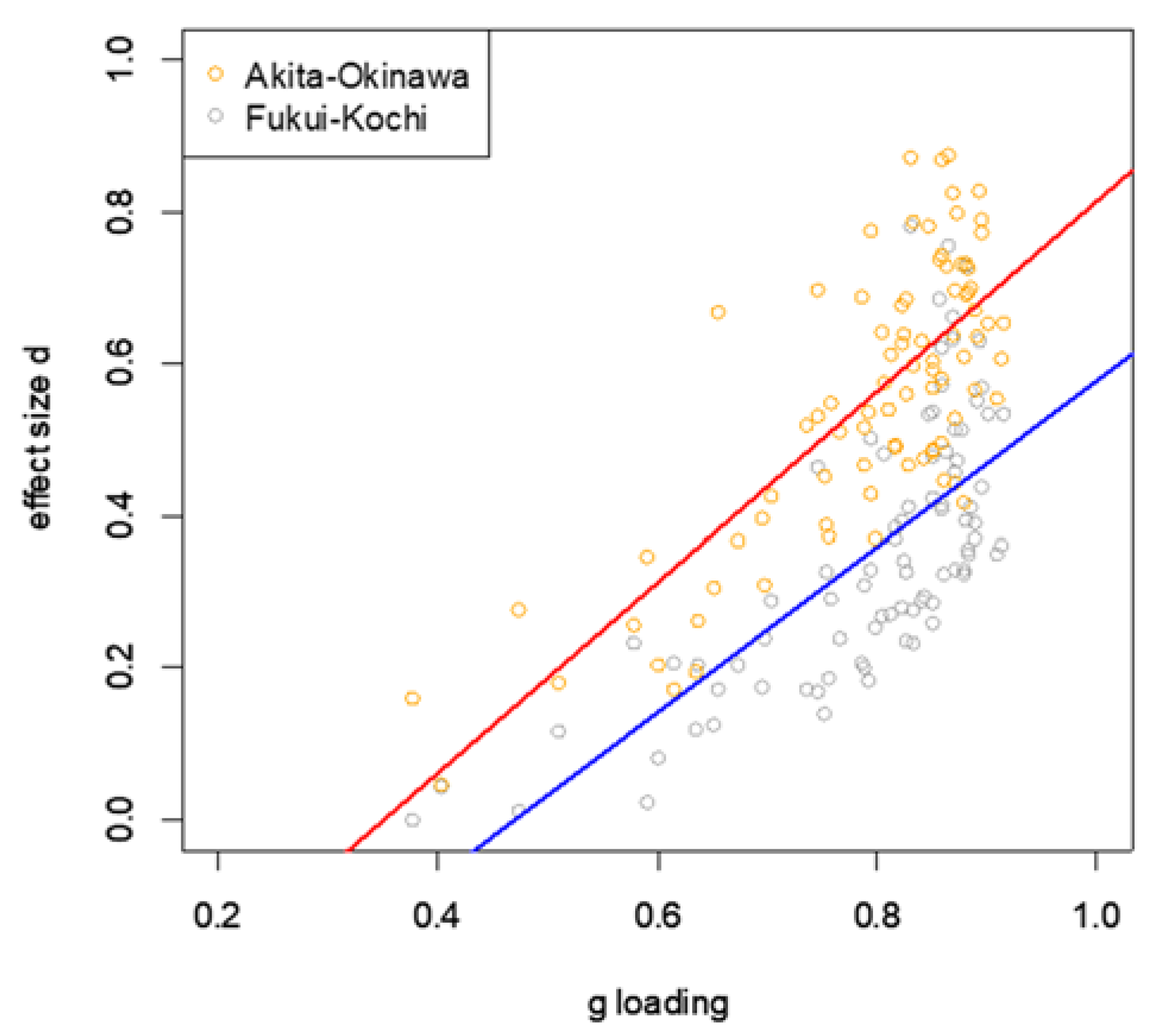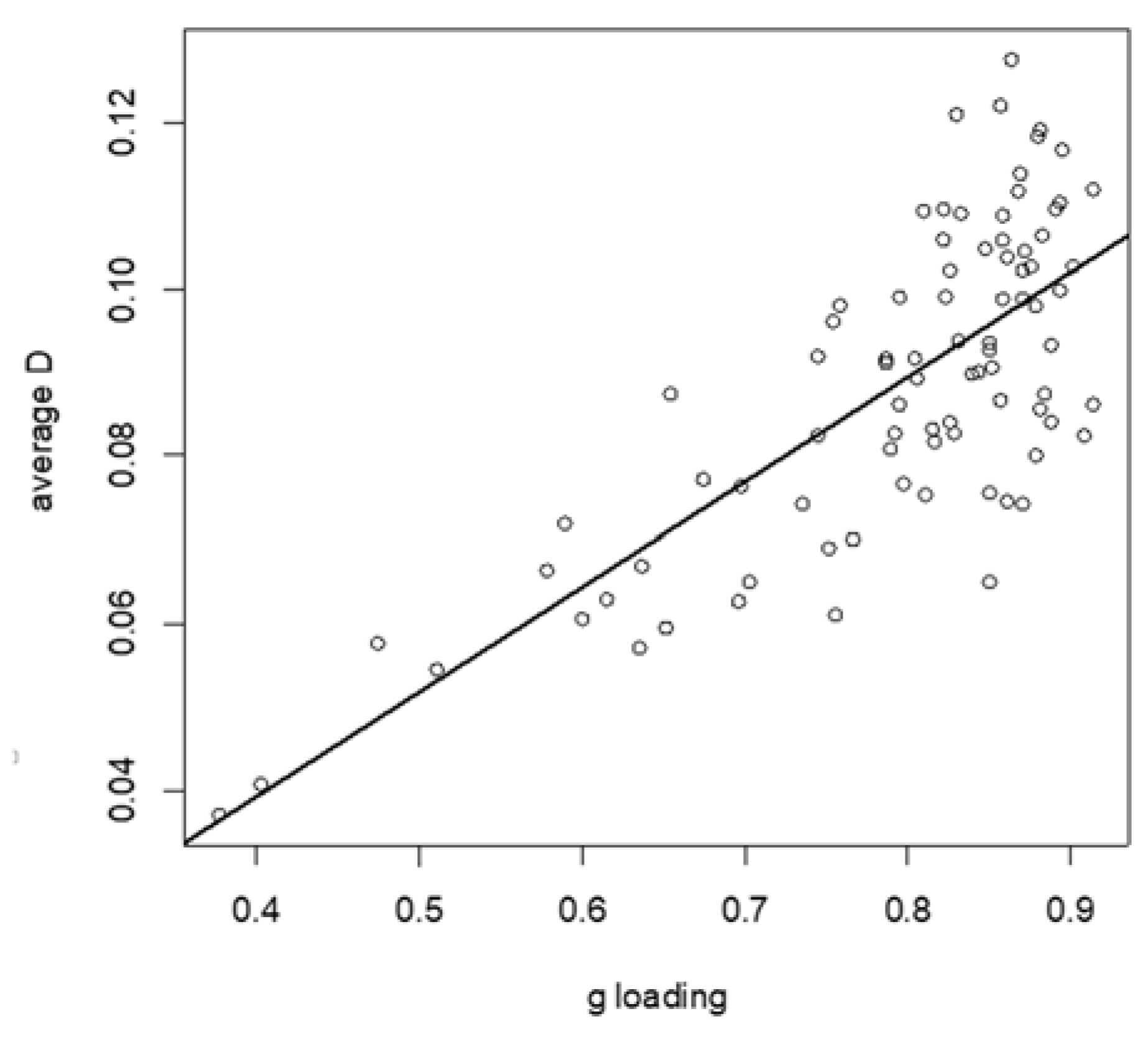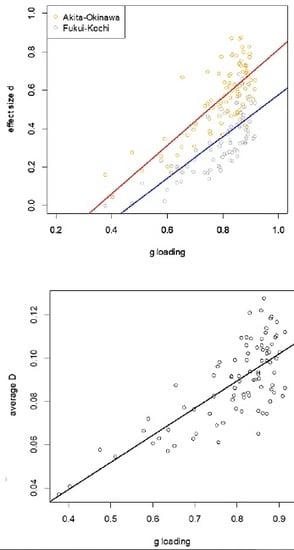Spearman’s Hypothesis Tested Comparing 47 Regions of Japan Using a Sample of 18 Million Children
Abstract
:1. Introduction
The varying magnitude of the mental difference between Black and White populations on a variety of mental tests is directly related to the size of test’s loading on g, the general factor, common to all complex tests of mental ability.
Why is Spearman’s hypothesis so important? Because, if proven true, not only would it answer the question, at least in part, of why the magnitude of the W–B differences varies across different tests, but, of greater general importance, it would tell us that the main source of the W–B difference across various cognitive tests is essentially the same as the main source of differences between individuals with each racial group, namely g. This proposition would imply that a scientific understanding of the nature of the W–B difference in fact depends on understanding the nature of g.
2. Methods
2.1. Sample
2.2. Tests
2.3. Statistical Analyses
2.3.1. Computing g Loadings
2.3.2. Computing ds
2.3.3. Average Distance D
2.3.4. Testing Spearman’s Hypothesis
3. Results
4. Discussion
Supplementary Materials
Author Contributions
Funding
Acknowledgments
Conflicts of Interest
References
- Spearman, C. General intelligence, objectively determined and measured. Am. J. Psychol. 1904, 15, 201–293. [Google Scholar] [CrossRef]
- Jensen, A.R. The g Factor: The Science of Mental Ability; Praeger: Westport, CT, USA, 1998. [Google Scholar]
- Thomson, G.H. A hierarchy without a general factor. Br. J. Psychol. 1916, 8, 271–281. [Google Scholar] [CrossRef]
- Thomson, G.H. On the cause of hierarchical order among the correlation coefficients of a number of variates taken in pairs. Proc. R. Soc. Lond. Ser. A 1919, 95, 400–408. [Google Scholar] [CrossRef]
- Jensen, A.R.; Shinha, S.N. Physical correlates of human intelligence. In Biological Approaches to the Study of Human Intelligence; Vernon, P.A., Ed.; Ablex: Norwood, NJ, USA, 1993; pp. 139–242. [Google Scholar]
- Shuey, A.M. The Testing of Negro Intelligence, 2nd ed.; Social Science Press: New York, NY, USA, 1966. [Google Scholar]
- Jensen, A.R. Bias in Mental Testing; The Free Press: New York, NY, USA, 1980. [Google Scholar]
- Jensen, A.R. The nature of the black-white difference on various psychometric tests: Spearman’s hypothesis. Behav. Brain Sci. 1985, 8, 193–263. [Google Scholar] [CrossRef]
- Jensen, A.R. Further evidence for Spearman’s hypothesis concerning the black-white differences on psychometric tests. Behav. Brain Sci. 1987, 10, 512–519. [Google Scholar] [CrossRef]
- Nyborg, H.; Jensen, A.R. Black-White differences on various psychometric tests: Spearman’s hypothesis tested on American armed services veterans. Personal. Individ. Differ. 2000, 28, 593–599. [Google Scholar] [CrossRef]
- Jensen, A.R.; Whang, P.A. Speed of accessing arithmetic facts in long-term memory: A comparison of Chinese-American and Anglo American children. Contemp. Educ. Psychol. 1994, 19, 1–12. [Google Scholar] [CrossRef]
- Te Nijenhuis, J.; van den Hoek, M.; Armstrong, E. LSpearman’s hypothesis and Amerindians: A meta-analysis. Intelligence 2015, 50, 87–92. [Google Scholar] [CrossRef]
- Te Nijenhuis, J.; David, H.; Metzen, D.; Armstrong, E.L. Spearman’s hypothesis tested on European Jews vs non-Jewish Whites and vs Oriental Jews: Two meta-analyses. Intelligence 2014, 44, 15–18. [Google Scholar] [CrossRef]
- Lynn, R.; Owen, K. Spearman’s hypothesis and test score differences between Whites, Indians, and Blacks in South Africa. J. Gen. Psychol. 1994, 121, 27–36. [Google Scholar] [CrossRef] [PubMed]
- Rushton, J.P.; Skuy, M. Performance on Raven’s Matrices by African and White university students in South Africa. Intelligence 2000, 28, 251–265. [Google Scholar] [CrossRef]
- Rushton, J.P.; Jensen, A.R. African-White IQ differences from Zimbabwe on the Wechsler Intelligence Scale for Children-Revised are mainly on the g factor. Personal. Individ. Differ. 2003, 34, 177–183. [Google Scholar] [CrossRef]
- Te Nijenhuis, J.; van der Flier, H. Comparability of GATB scores for immigrants and majority group members: Some Dutch findings. J. Appl. Psychol. 1997, 82, 675–687. [Google Scholar] [CrossRef]
- Te Nijenhuis, J.; van der Flier, H. Bias research in the Netherlands: Review and implications. Eur. J. Psychol. Assess. 1999, 15, 165–175. [Google Scholar] [CrossRef]
- Te Nijenhuis, J.; Willigers, D.; Dragt, J.; van der Flier, H. The effects of language bias and cultural bias estimated using the method of correlated vectors on a large database of IQ comparisons between native Dutch and ethnic minority immigrants from non-Western countries. Intelligence 2016, 54, 117–135. [Google Scholar] [CrossRef]
- Fuerst, J. Ethnic/Race Differences in Aptitude by Generation in the United States: An Exploratory Meta-analysis. Open Differ. Psychol. 2014. [Google Scholar] [CrossRef]
- Warne, R.T. Testing Spearman’s hypothesis with advance placement examination data. Intelligence 2016, 57, 87–95. [Google Scholar] [CrossRef]
- Te Nijenhuis, J.; van den Hoek, M.; Metzen, D.; David, H. Spearman’s hypothesis not supported? Three meta-analyses of Black and White prisoners, Northeast Asians, and Arabs and Jews. Personal. Individ. Differ. 2017, 117, 52–59. [Google Scholar] [CrossRef]
- Helms-Lorenz, M.; Van de Vijver, F.J.R.; Poortinga, Y.H. Cross-cultural differences in cognitive performance and Spearman’s hypothesis: g or c? Intelligence 2003, 31, 9–29. [Google Scholar] [CrossRef]
- Te Nijenhuis, J.; van der Flier, H. Immigrant-majority group difference in cognitive performance: Jensen effects, cultural effects, or both? Intelligence 2003, 31, 443–459. [Google Scholar] [CrossRef]
- Dolan, C.V. Investigating Spearman’s hypothesis by means of multi-group confirmatory factor analysis. Multivar. Behav. Res. 2000, 35, 21–50. [Google Scholar] [CrossRef] [PubMed]
- Lubke, G.H.; Dolan, C.V.; Kelderman, H. Investigating group differences on cognitive tests using Spearman’s Hypothesis: An evaluation of Jensen’s method. Multivar. Behav. Res. 2001, 36, 299–324. [Google Scholar] [CrossRef] [PubMed]
- Ashton, M.C.; Lee, K. Problems with the method of correlated vectors. Intelligence 2005, 33, 431–444. [Google Scholar] [CrossRef]
- Van Der Maas, H.L.J.; Dolan, C.V.; Grasman, R.P.P.P.; Wicherts, J.M.; Huizenga, H.M.; Raijmakers, M.E.J. A dynamical model of general intelligence: The positive manifold of intelligence by mutualism. Psychol. Rev. 2006, 113, 842–861. [Google Scholar] [CrossRef] [PubMed]
- Te Nijenhuis, J.; Batterjee, A.A.; van den Hoek, M.; Allik, J.; Sukhanovskiy, V. Spearman’s hypothesis tested comparing Saudi Arabian children and adolescents with various other groups of children and adolescents on the items of the Standard Progressive Matrices. J. Biosoc. Sci. 2017, 49, 634–647. [Google Scholar] [CrossRef] [PubMed]
- Te Nijenhuis, J.; van den Hoek, M. Spearman’s hypothesis tested on Black adults: A meta-analysis. J. Intell. 2016, 4, 6. [Google Scholar] [CrossRef]
- Te Nijenhuis, J.; Choi, Y.Y.; van den Hoek, M.; Valueva, E.; Lee, K.H. Spearman’s hypothesis tested comparing Korean young adults with various other groups of young adults on the items of the Advanced Progressive Matrices. J. Biosoc. Sci. 2018. forthcoming. [Google Scholar]
- Woodley, M.A.; te Nijenhuis, J.; Must, O.; Must, A. Controlling for increased guessing enhances the independence of the Flynn effect from g: The return of the Brand effect. Intelligence 2014, 42, 27–34. [Google Scholar] [CrossRef]
- Lynn, R. In Italy, north-south differences in IQ predict differences in income, education, infant mortality, stature, and literacy. Intelligence 2010, 38, 93–100. [Google Scholar] [CrossRef]
- Lynn, R. IQ differences between the north and the south of Italy: A reply to Beraldo and Cornoldi, Belacchi, Giofre, Martini, and Tressoldi. Intelligence 2010, 38, 451–455. [Google Scholar] [CrossRef]
- Beraldo, S. Do differences in IQ predict Italian north-south differences in income? A methodological critique to Lynn. Intelligence 2010, 38, 456–461. [Google Scholar] [CrossRef]
- Cornoldi, C.; Belacchi, C.; Giofrè, D.; Martini, A.; Tressoldi, P. The mean Southern Italian children IQ is not particularly low: A reply to R. Lynn. Intelligence 2010, 38, 462–470. [Google Scholar] [CrossRef]
- Kura, K. Japanese north-south gradient in IQ predicts differences in stature, skin color, income, and homicide rate. Intelligence 2013, 41, 512–516. [Google Scholar] [CrossRef]
- Carl, N. IQ and Socioeconomic development across the regions of the UK. J. Biosoc. Sci. 2016, 48, 406–417. [Google Scholar] [CrossRef] [PubMed]
- Carl, N. IQ and socio-economic development across local authorities of the UK. Intelligence 2016, 55, 90–94. [Google Scholar] [CrossRef]
- Lynn, R. North–south differences in Spain in IQ, educational attainment, per capita income, literacy, life expectancy and employment. Mank. Q. 2012, 52, 265–291. [Google Scholar]
- Roivainen, E. Economic, educational, and IQ gains in eastern Germany 1990–2006. Intelligence 2012, 40, 571–575. [Google Scholar] [CrossRef]
- Lynn, R.; Sakar, C.; Cheng, H. Regional differences in intelligence, income and other socio-economic variables in Turkey. Intelligence 2015, 50, 144–149. [Google Scholar] [CrossRef]
- Dutton, E.; Bakhiet, S.; Ziada, K.; Essa, Y.; Ali, H.; Alqafari, S. Regional difference in intelligence in Egypt: A country where upper is lower. J. Biosoc. Sci. 2018, 1, 9. [Google Scholar] [CrossRef]
- Flynn, J.R.; te Nijenhuis, J.; Metzen, D. The g beyond Spearman’s g: Flynn’s paradoxes resolved using four exploratory meta-analyses. Intelligence 2014, 44, 1–10. [Google Scholar] [CrossRef]
- Frey, M.C.; Detterman, D.K. Scholastic assessment or g?: The relationship between the scholastic assessment test and general cognitive ability. Psychol. Sci. 2004, 15, 373–378. [Google Scholar] [CrossRef] [PubMed]
- Koenig, K.A.; Frey, M.C.; Detterman, D.K. ACT and general cognitive ability. Intelligence 2008, 36, 153–160. [Google Scholar] [CrossRef]
- NIER, National Institute for Educational Policy Research, Japan. The Result of the National Achievement Tests. 2018. Available online: https://www.nier.go.jp/kaihatsu/zenkokugakuryoku.html (accessed on 3 February 2019).
- R Core Team. R: A language and environment for statistical computing. R Foundation for Statistical Computing: Vienna, Austria, 2018. ISBN3-900051-09-7. Available online: https://www.r-project.org/ (accessed on 3 February 2019).
- Hammer, M.F.; Karafet, T.M.; Park, H.; Omoto, K.; Hirihara, S.; Stoneking, M.; Horai, S. Dual origins of the Japanese: Common ground for hunter-gatherer and farmer Y chromosomes. J. Hum. Genet. 2006, 51, 47–58. [Google Scholar] [CrossRef] [PubMed]
- Rushton, J.P.; Jensen, A.R. Thirty years of research on race differences in cognitive ability. Psychol. Public Policy Law 2005, 11, 235–294. [Google Scholar] [CrossRef]


| Method | N of Test Scores | Prefectures | r | ρ |
|---|---|---|---|---|
| Year 2007–2018 | 86 | Akita–Okinawa | 0.77 *** | 0.66 *** |
| Fukui–Kochi | 0.71 *** | 0.74 *** |
© 2019 by the authors. Licensee MDPI, Basel, Switzerland. This article is an open access article distributed under the terms and conditions of the Creative Commons Attribution (CC BY) license (http://creativecommons.org/licenses/by/4.0/).
Share and Cite
Kura, K.; te Nijenhuis, J.; Dutton, E. Spearman’s Hypothesis Tested Comparing 47 Regions of Japan Using a Sample of 18 Million Children. Psych 2019, 1, 26-34. https://doi.org/10.3390/psych1010002
Kura K, te Nijenhuis J, Dutton E. Spearman’s Hypothesis Tested Comparing 47 Regions of Japan Using a Sample of 18 Million Children. Psych. 2019; 1(1):26-34. https://doi.org/10.3390/psych1010002
Chicago/Turabian StyleKura, Kenya, Jan te Nijenhuis, and Edward Dutton. 2019. "Spearman’s Hypothesis Tested Comparing 47 Regions of Japan Using a Sample of 18 Million Children" Psych 1, no. 1: 26-34. https://doi.org/10.3390/psych1010002
APA StyleKura, K., te Nijenhuis, J., & Dutton, E. (2019). Spearman’s Hypothesis Tested Comparing 47 Regions of Japan Using a Sample of 18 Million Children. Psych, 1(1), 26-34. https://doi.org/10.3390/psych1010002






